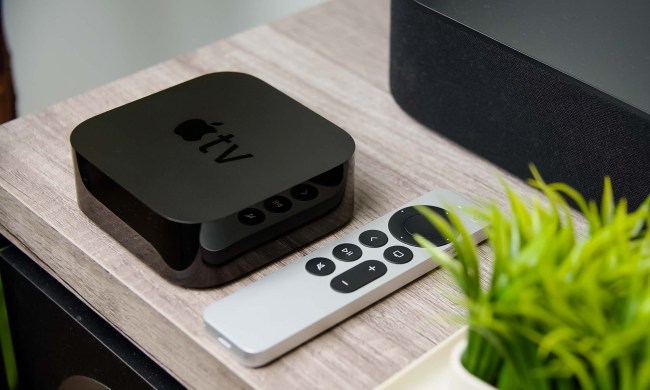- Great sound clarity; appealing aesthetics; decent volume
- Slightly weak bass; smudging surfaces
Summary
The Logitech Z-4 is an all-around top performer in the 2.1 speaker category. The appealing modern design, though fingerprint prone, is modern but not gaudy, though some may be put off by the prominent Logitech logos. The controls are tight and accurate, with the control panel sporting headphone and auxiliary in. While the bass could use a little more punch on the lower frequencies, the sound quality was first rate. Read our full review.
Features and Design
With the craze over 5.1, 6.1, and now 7.1 speaker packages, it’s easy to forget that there are many situations where a simple 2.1 setup is preferable. After all, who wants to run a gauntlet of wires around their office, or set up rear channel speaker stands in the aisle behind their cubicle? Many companies have opted for watered down versions of their 5.1+ systems, chopping the subwoofer down a notch and calling it a day. Others have decided to forgo the subwoofer entirely, leaving listeners without the satisfaction of a respectable bass line. And then there is the third category: Companies that invest in 2.1 setups intended to be 2.1, and engineered around the best quality for the most common usage of such a system. Logitech is one such company, and the Z-4 speaker system is a great example of what happens when a company takes into account consumer feedback and designs a product for an intended use, rather than just borrowing spare parts from other lines.
The Logitech Z-4 is the follow up to the Z-3, which we reviewed earlier, but with some major design changes. They ditched the wood finish, opting for a metallic silver finish. For those that need to coordinate everything with their iPod, there is a Z-4i version that is identical to the regular Z-4, but wrapped in the iconic white plastic. The satellite cables are not separate for each speaker and plug directly into the subwoofer, as does the control unit. This eliminates the annoying slipping seen with the Z-3. Also, the subvolume has been moved from the ever-inaccessible depths of the area below the desk to the control unit. Also, the protective cover that came with the Z-3 has been eliminated. Judging from our own review, and other reviews on various websites, these changes address all the major complaints leveled at the Z-3. How often does that happen?
Out of the box, you get the two satellites, subwoofer, control unit, stereo cord, quick start sheet, and power cord. Setup is, as expected, ridiculously easy. The satellites use a heavier metal in the stands to keep the speakers from tipping, and offer no ability to tilt. Each contains three drivers: Two 2″ pressure drivers and one 2″ dome driver. The driver arrangement is designed to allow the satellites better mid/low frequency response. The outside surface is a matte silver finish, while the front surface surrounding the silver drivers is a glossy black. The Logitech logo adorns the middle of the top driver, with “Z-4″ on the bottom one. We found this unappealing, but because the logos are in a slightly darker gray than the background, they don’t attract much attention. The 8” subwoofer is slightly large for a 2.1 setup, but also uncomfortably light, making us worry about the ability to really catch those lower frequencies. The control unit plugs into the subwoofer, as do the satellites, and features the same color scheme as the satellites. Although the frequency response and power output are identical to the Z-3, you can bet with the driver changes that the Z-4 will have a different sound signature. Frequency response is rated at 35Hz-20KHz, peak power at 80 watts, and RMS power sends 23 watts to the subwoofer and 8.5 watts to each satellite.
The control unit has been much improved over the Z-3. The same blue LED indicates the speakers are powered, there is a headphone port, and the knob is large, but the similarities to the Z-3 end there. As mentioned earlier, the subvolume knob has been moved to the control pad in the form of a smaller, offset knob. The headphone port is set next to the auxiliary line input, which is a new addition. Sound can be played through both the auxiliary input and the main input at once. In fact, there’s no way to choose which one is active. It may sound counterintuitive, but we found that this setup is actually preferable. There’s never a need to switch inputs, since you just mute one source. Also, plugging in headphones automatically mutes the speakers, with no manual control to turn it off. Logitech obviously designed the system around simplicity, but more importantly, around the common use of 2.1 systems. The Z-4 is great for everyday use, and requires no fiddling.
Image Courtesy of Logitech
Performance
But how do they sound? We tested the Z-4s after a very brief 10-hour burn in. If there is a significant change in audio quality with use, you can be sure it will be posted in the forum thread on this review. Even out of the box we were immediately impressed with the sound clarity. The sound is accurate at all levels. We thought the highs could get a little tinny at very high frequencies, and the lows didn’t reach quite as far as we would have liked. This is a critical review of the sound characteristics, though, and overall we were very satisfied. The midrange was very clear, with the satellites performing exceptionally well at lower frequencies, thanks to the design changes. What surprised us most was how loud the Z-4s could get, and still pump out quality sound. Suffice it to say, for office applications there is easily enough volume to satisfy most users. After about half the maximum volume, the bass would begin to drop out slightly, and the absence of the lower frequencies was more noticeable. To convey some idea of how loud the Z-4s can get, as this review is being written, they are playing at ¼ maximum volume while in a public office. If we were to turn up the volume to half, it would attract the attention of the people down the hall.
Our audition selection consisted of techno, ethereal, rock, and jazz. All sounded very good. The weaker deep bass levels worked mostly against the jazz and ethereal. Techno tracks could get slightly harsh at the higher frequencies, but did not suffer from a lack of bass. The particular part of the spectrum underrepresented is found in more analog or atmospheric background settings. In electronic music, the bass was very strong, even with the sub volume at half max. Rock music and Britpop sounded excellent, showing off the system’s ability to dish out very accurate vocal tones.
Conclusion
The Logitech Z-4 should be at the top of your list of <$100 speaker systems if you’re in the market for a good 2.1 setup. All the major design flaws of the previous generation have been addressed, resulting in a truly consumer-friendly design. The Z-4s can be driven hard and loud and still belt out accurate sound, and with a sleek modern appearance, you can be assured that they look as good as they sound.
Pros:
– Great sound clarity
– Appealing aesthetics
– Decent volume level
Cons:
– Slightly weak bass
– The speaker surfaces smudge easily





